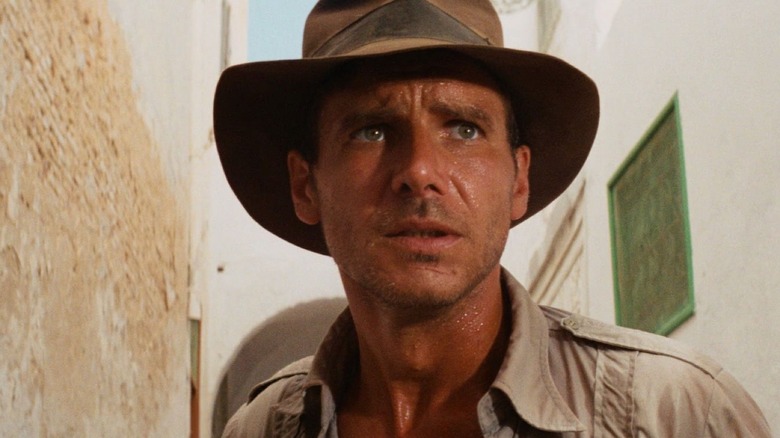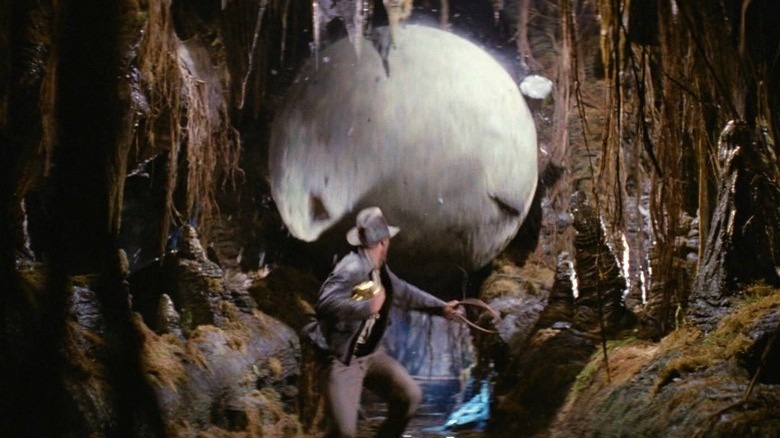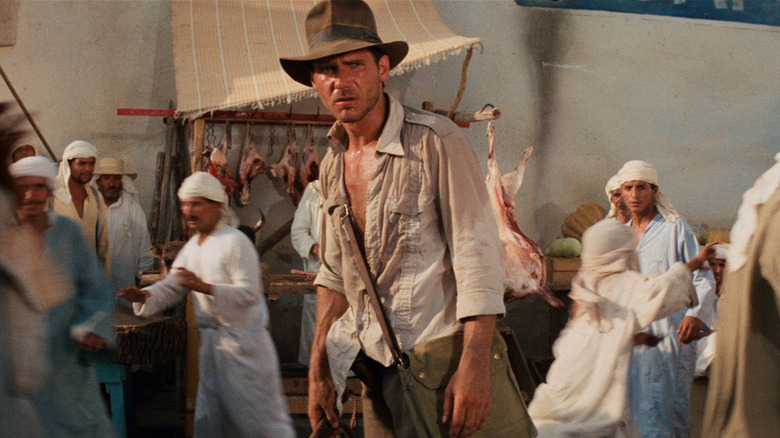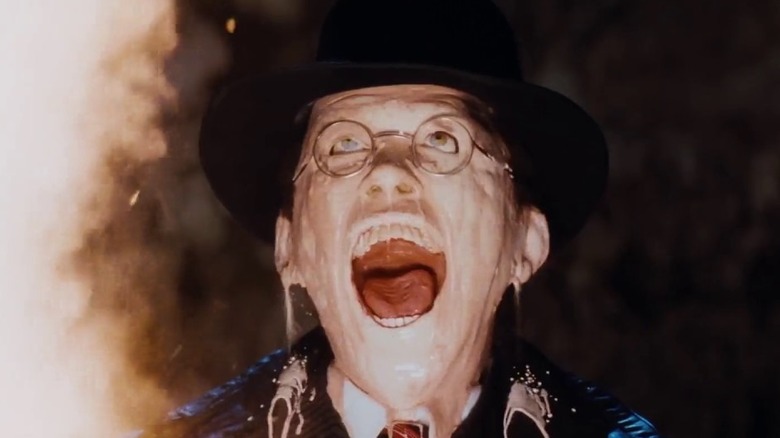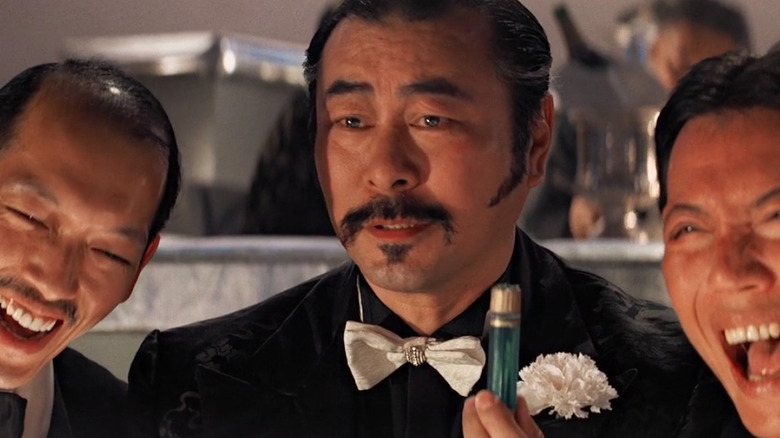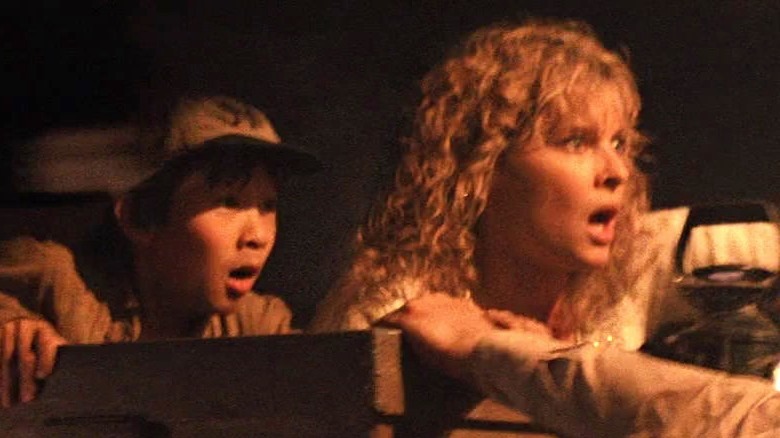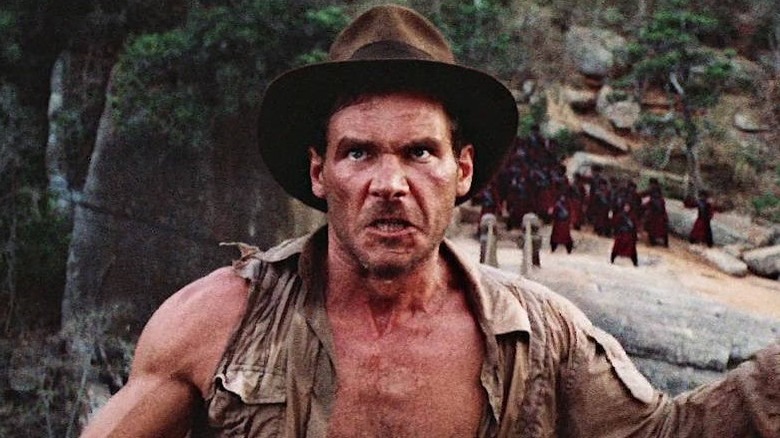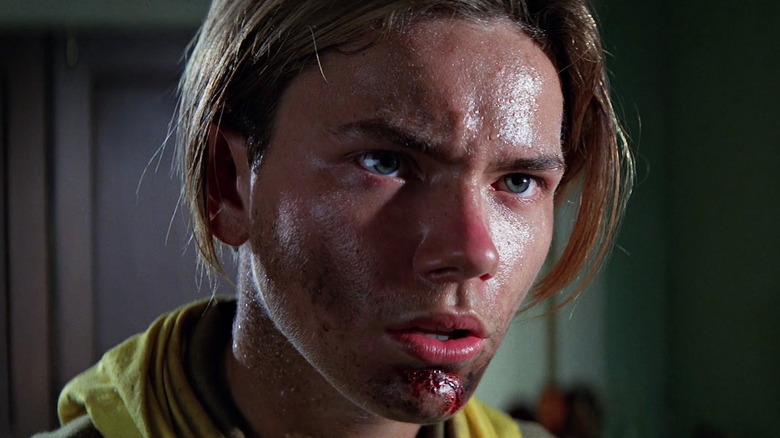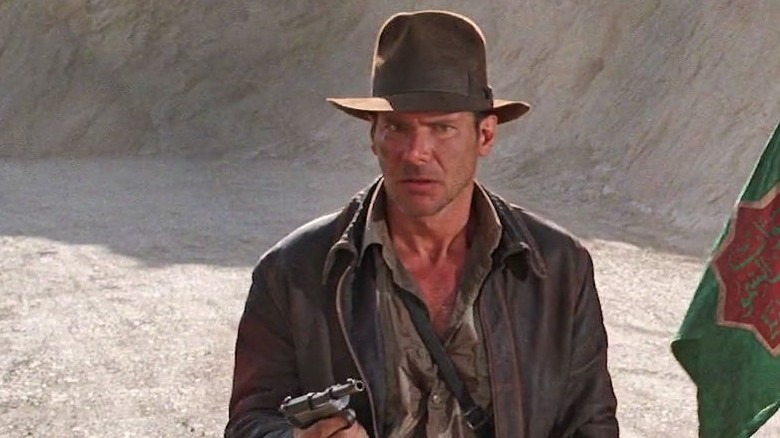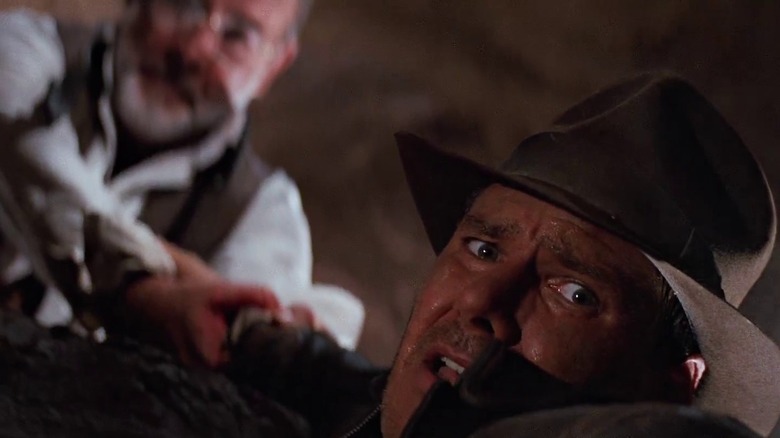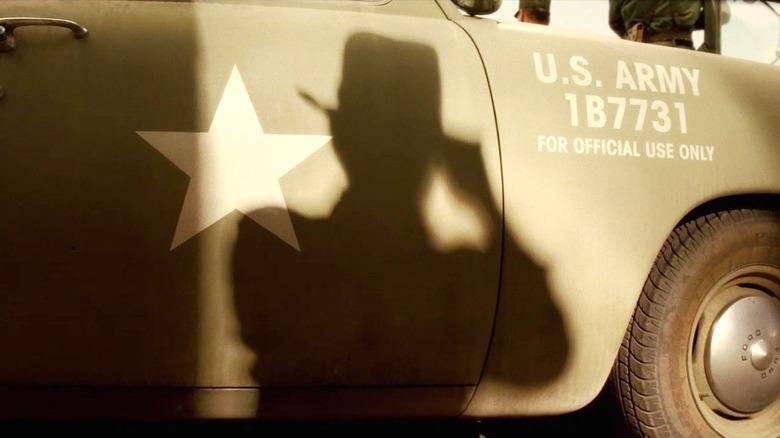10 Coolest Moments From The Indiana Jones Franchise (So Far)
From the bullwhip to his iconic fedora, there's plenty about Dr. Henry Jones Jr. that has amazed and delighted movie fans throughout the years. Ever since Indiana Jones made his big-screen debut in 1981's "Raiders of the Lost Ark," action-packed cinema has never quite been the same. With Harrison Ford leading the way and John Williams' marching score soundtracking each nail-biting quest, the franchise swiftly became a living embodiment of its own tagline: "If adventure has a name, it must be Indiana Jones."
Cut to today, and Dr. Jones' tomb-raiding exploits aren't over just yet. With Ford's fifth, and presumably final, adventure due to arrive in 2023, "Indiana Jones and the Dial of Destiny" looks to end Indy's journey with a time-hopping bang, this time under the directorial eye of filmmaker James Mangold, who takes the reins from original series helmsman Steven Spielberg. While we'll have to wait a few months to figure out how Indy's treasure-seeking adventures wrap up, thankfully we still have four previous outings to revisit until he takes his final stroll into the sunset.
So, while we wait for "Dial of Destiny" to arrive, let's look back at some of the coolest moments from the "Indiana Jones" franchise so far. From brushes with boulders to dodgy-looking rope bridges that you wouldn't want to hang about on, Indiana Jones has had his fair share of narrow escapes over the years. Here are 10 of the best.
Boulder chase
Let's start at the beginning. When you think of Indiana Jones, arguably it's this scene that springs to mind first. This whole sequence — the opening prelude to Steven Spielberg's 1981 classic "Raiders of the Lost Ark" — is packed with lots of little classic moments. In it, we first meet Indiana Jones, as he's introduced through a series of perilous encounters within an ancient tomb. Accompanied by two untrustworthy locals, we watch with bated breath as he makes his way deeper and deeper inside the ancient building, setting off booby trap after booby trap as he goes.
There are spikes firing out from the walls and poison darts shooting from unseen passageways directly toward the tomb's intruders — both classic motifs from the adventure serials that Spielberg and co-creator George Lucas were pulling from when building this world. However, it's the sequence's biggest moment that sticks in the memory — one of a giant boulder falling from on high and chasing Indy through the collapsing temple.
If the scene looks too good to be true, that's because it almost was. The boulder itself was 12 feet tall and weighed approximately 300 pounds — meaning it would've happily squashed anyone that found themselves in its way. Years later, Spielberg branded himself an "idiot" in a self-penned essay for American Cinematographer for letting leading man Harrison Ford do the stunt himself.
Gun vs. sword
One of the best things about the "Indiana Jones" movies is that they don't skimp on sending our fedora-wearing hero to all corners of the world in order to achieve his archaeological goals. In this instance, the fatigue brought on by Indy's globe-trotting endeavors may have actually been responsible for giving us one of the most memorable "Indiana Jones" scenes. It's brief — but ask any fan and it'll likely be near the top of their list of best Indy moments. When the hero faces off against a grinning swordsman in a sweltering Cairo market, audiences are expecting to see a swashbuckling swordfight play out. However, Indy cuts the action short and simply shoots his assailant.
Nice, easy, and funny, right? Well, according to Steven Spielberg's longtime producing partner Frank Marshall, the whole thing may have been the product of a tight schedule and a tired star. "We had been shooting in Tunisia in 130 degrees for six weeks and we had three days left," explained Marshall during an Oscar roundtable chat in 2016. "We were supposed to shoot this huge fight between the whip and the sword. It took the whole morning to shoot just three storyboards." He continued, adding: "Somehow, somebody said, 'I've got this gun, why don't I just use it?' After lunch, we did three shots, and we were two days ahead of schedule, and it's the biggest moment in the movie."
Face melt
Every "Indiana Jones" movie has a MacGuffin — an object the cast is looking for that's primarily used to drive the film's action or plot. In "Raiders of the Lost Ark," it was the Ark of the Covenant, and when it was finally found, its new Nazi owners just couldn't wait to crack it open. As it turns out, they might have wished they hadn't. While Indy has the good sense to tell Marion Ravenwood (Karen Allen) not to look inside the Ark, the film's goose-stepping baddies aren't quite as smart.
Once open, ghouls fly out of it, swirling their way in and around the film's villains, ultimately melting the head of the Gestapo agent, Toht (Ronald Lacey). "Steven [Spielberg] was just yelling at us: 'Look this way! Look up! look down! It's horrible! It's coming at you! It's moved away! It's coming over to the left! Keep looking!' We were just reacting like that instantly, with no idea what we were looking at," actor Paul Freeman (who played Indy's nemesis, René Belloq) told USA Today, commenting on the confusing nature of shooting digital effects when they were far from commonplace.
The "Raiders of the Lost Ark" ending is still a moment people ask him about all the time: "They usually say, 'How did they do that with your head?' As if, how surprising I've still got a head," laughs Freeman. "Or they say, 'What was inside the ark?' Well, a bit of sand ... but that's all. The magic was added later."
Temple of Doom intro
A lot of people seem to have conflicted feelings about the first "Indiana Jones" followup, 1984's "Indiana Jones and the Temple of Doom." Much of its sinister streak has since been blamed on George Lucas going through a particularly nasty divorce during the writing of the sequel. However, while its darker tones are clearly evident throughout, one thing you can't knock the film for is its ability to cram as much action and adventure into its runtime as physically possible. What's more, this ethos is hit home straight from the get-go, with Steven Spielberg wasting no time in setting the scene for one of Jones' most action-packed quests.
Within the first 20 minutes, Indy is poisoned, forced to chase down an antidote, is shot at, and narrowly escapes the crazed crime lord Lao Che (Roy Chiao) via the help of his pint-sized pal Short Round (Key He Quan) and the less-than-helpful dancer Willie Scott (Kate Capshaw). It doesn't stop there, though. After being conned into boarding a corrupt plane, Indiana soon finds himself forced to make an emergency landing, using an inflatable life raft as whatever the opposite of a parachute is to help him land safely in Northern India. Did we say safely? Indy, Short Round, and Willie soon find themselves plunging off a huge waterfall seconds later. Talk about an arresting opening.
Mine car chase
In many ways, "Temple of Doom" helped solidify the Indiana Jones we all know and love today. It was the first movie in the franchise that put Dr. Jones' name front and center in its title — something that has since become a staple for all of his future adventures — and its tone was decidedly darker in nature. This is something that's been dripped through the franchise; with every out-there installment like "Temple of Doom," there's a more grounded adventure like "Indiana Jones and the Last Crusade" to balance things out.
That said, "Temple of Doom" definitely delivered on the action and adventure element, something that's perfectly encapsulated in the movie's high-octane mine-car chase sequence. After fighting off a sinister possession from a mystical curse, Indy sets his sights on securing the film's sacred Sankara Stones and returning all of the abducted children home — but first, he has to escape. Cue a mine car chase that sends Indy, Short Round, and Willie careening throughout the Thuggee cult's underground cave stronghold.
This sequence arguably embodies everything that's good about the "Indiana Jones" movies: It's unexpected, non-stop, and nailbiting, but never forgets to add a dash of humor. Watching Indy try to stop the mine car with his flimsy workman shoes, only for them to catch fire, sending him hot-footing around in search of water is the perfect cherry on top of this sequence. Actually, maybe that's the huge flood that appears from nowhere and answers his pleas.
Rope bridge
How do you top off perhaps the most action-packed "Indiana Jones" adventure ever? How about sticking our heroes in the middle of a rickety old rope bridge, surrounding them with baddies from every possible angle, and then asking Indy to improvise some kind of escape? Sounds in keeping with "Temple of Doom," a film that grabs you firmly by the Sankara Stones and refuses to let up until the credits roll.
After narrowly escaping the cavernous Thuggee hideout and freeing the child workers imprisoned within, Indy finds himself near victory, but his journey has taken him straight into the middle of a perilous rope bridge with no escape route in sight. The solution? Hold on tight, cut the rope, and hope for the best. As it turns out, this scene was just as nail-biting in reality as it is on the big screen. During production, Steven Spielberg commissioned a local dam-building company to build a real-life rope bridge — and while it was safe, it sure looked scary.
"I have a terrible fear of heights and when the bridge was finished I could go out 40 yards from either end," explained Spielberg in "Temple of Doom" Blu-ray extras (via Express). "Harrison, in the meantime, said: 'Oh that's nothing! He ran across the bridge, first time he got on the bridge, he ran as fast as he could from one end to the other. I couldn't believe he did that," he added. "But that's Harrison Ford. He's Indiana Jones!"
Young Indiana Jones
"Indiana Jones and the Last Crusade" returned Indy to his roots with an adventure similar in tone and aesthetic to "Raiders of the Lost Ark." It also illuminated a key moment in young Indy's life, one that helped shape the morals of the famed archeologist.
We open in 1912 when a young Henry Jones Jr. (River Phoenix) spies grave robbers stealing a gold crucifix, with plans to sell it to an antiquities dealer. Even as a tenacious boy scout, young Indy knows that items like that belong in a museum — and so begins an action-packed opener where Henry tries to get this stolen artifact to the authorities while encountering some key elements of Indy lore, like his fascination with a bullwhip and how he got that iconic chin scar.
While he ultimately fails in his quest, it still proves to be a formative moment as an older, work-for-hire archaeologist with a familiar leather jacket and fedora — a sort of alternative Indiana Jones, if his morals weren't as well placed — informs our adolescent hero, "You lost today, kid. But that doesn't mean you have to like it." Gifting him his fedora, we transition to modern-day Indy, who's once again chasing the same corrupt dealer he lost out to all those years back. It's a prelude to the main story, but one that does wonders for illustrating exactly who this character is — and why.
Tank battle
Much like the truck chase scene in "Raiders of the Lost Ark," and the mine cart chase in "Temple of Doom," the tank battle in "Last Crusade" is, in many ways, peak Indiana Jones. After spending the majority of the movie chasing down the whereabouts of the Holy Grail, Indy's third adventure leads him to a perilous tank battle, in which his father, Henry Jones Sr. (Sean Connery), and longtime buddy Marcus Brody (Denholm Elliott) have been kidnapped by the Nazis. With his allies held in a tank, it's up to Jones Jr. to tackle enemy artillery and punch his way to victory.
Like any key sequence in an "Indiana Jones" movie, this extended action scene is memorable for a number of reasons, not least of all for how the whole thing was choreographed. Combining complex fighting, interactions that push the battle narrative forward, and a heady dose of tension, for more than a brief moment, you forget you're watching a movie and are 100% invested in how Indy will get out of this nail-biting scrape.
Steven Spielberg is sure to finesse it with some levity right at the very end. Just as the audience and Henry Sr. think Indiana has fallen to his death, he reappears at the last moment, punctuating the scene with a sigh of relief and — when his fedora coincidentally breezes back into the shot — humor too.
Indiana, let it go ...
There's a moment in "Temple of Doom" where Dr. Jones explains to Short Round why he believes nefarious people are searching for the magical Sankara Stones: "Fortune and glory, kid. Fortune and glory." While not specifically referenced within "Last Crusade," this ethos of searching out ancient antiquities in order to parlay them for money and power is a thread that runs throughout the series.
It's something baked into the DNA of "Last Crusade." As we see young Indy try to retrieve the stolen crucifix from grave robbers in the film's opening moments, we learn more about the morals that guide this character and his dedication to doing what's right in order to respect the importance of history. After seeing his father be consumed by a search for one such antiquity, the Holy Grail, to the detriment of his parenting skills, Indy seems to be determined not to let the search for fortune and glory take over his own life.
That's put to the test during the final moments of "The Last Crusade." With the rediscovered Holy Grail on the cusp of being lost again down into the darkness of a crumbling temple, Indy suddenly finds it within his grasp — but the risk of him falling to his death is high. It's here where his father gently reminds him of who he really is, imploring him to "let it go ..."
Trunk reveal
Only one "coolest scene" from "Kingdom of the Crystal Skull?" While Indy's fourth and probably most divisive adventure is known for erm ... many things, it's not without its fair share of action-packed sequences and fan service moments. While overall reviews remain mixed, there are plenty of standout setpieces to be found within it, the biggest of which is the introductory scene. It's a sequence that's come to hold a certain significance within any "Indiana Jones" movie ever since that giant boulder nearly squashed our hero all those years ago.
Niche down further and one item of iconography that's become just as important as Indy's whip and fedora is his silhouette; something that's instantly recognizable from a single glance. This motif is utilized to help mark Jones' return following a 19-year absence. After opening with a toe-tapping hot rod car chase in the desert between a bunch of sinister-looking army folks and some joy-riding teens, we watch as the troops veer off into a mystery base, where two people are forcibly removed from a truck's trunk.
Layering the anticipation perfectly, Steven Spielberg teases Indy's full reveal — first with his fedora, then by shrouding his face as he's dragged out of the truck and thrown to the ground, surrounded by gun-wielding troops. Eventually, we see feet shuffle around, a hand scoop up the fedora, and then that iconic shadow cast on the door of the truck. Just like that, we're back in business.
